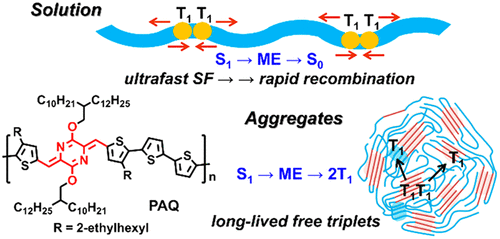当前位置:
X-MOL 学术
›
J. Am. Chem. Soc.
›
论文详情
Our official English website, www.x-mol.net, welcomes your feedback! (Note: you will need to create a separate account there.)
Singlet Fission in a para-Azaquinodimethane-Based Quinoidal Conjugated Polymer
Journal of the American Chemical Society ( IF 15.0 ) Pub Date : 2020-10-12 , DOI: 10.1021/jacs.0c06604 Long Wang 1 , Xuncheng Liu 2, 3 , Xiaomei Shi 4 , Christopher L. Anderson 2, 5 , Liana M. Klivansky 2 , Yi Liu 2 , Yishi Wu 6 , Junwu Chen 3 , Jiannian Yao 7 , Hongbing Fu 6
Journal of the American Chemical Society ( IF 15.0 ) Pub Date : 2020-10-12 , DOI: 10.1021/jacs.0c06604 Long Wang 1 , Xuncheng Liu 2, 3 , Xiaomei Shi 4 , Christopher L. Anderson 2, 5 , Liana M. Klivansky 2 , Yi Liu 2 , Yishi Wu 6 , Junwu Chen 3 , Jiannian Yao 7 , Hongbing Fu 6
Affiliation

|
The exploitation of singlet fission (SF) in photovoltaic devices is restricted by the limited number of SF materials available and the conflicting requirement of intermolecular interactions to satisfy both efficient SF and subsequent triplet extraction. Intramolecular SF (iSF) represents an emerging alternative and may prove simpler to implement in devices. On account of the excellent chemical structure tunability and solution processability, conjugated polymers have emerged as promising candidates for iSF materials despite being largely underexplored. It remains a significant challenge to develop SF-capable conjugated polymers and achieve efficient dissociation of the formed triplet pairs simultaneously. In this contribution, we present a new iSF material in a para-azaquinodimethane-based quinoidal conjugated polymer. Using transient optical techniques, we show that an ultrafast iSF process dominates the deactivation of the excited state in such polymer, featuring ultrafast population (<1 ps) and stepwise dissociation of triplet pairs. Notably, these multiexciton states could further diffuse apart to produce long-lived free triplets (tens of μs) in strongly coupled aggregates in solid thin film. Such findings not only introduce a new iSF-active conjugated polymer to the rare SF material family but also shed unique insight into interchain interaction-promoted triplet pair dissociation in aggregates of conjugated polymers, thus openning new avenues for developing next-generation SF-based photovoltaic materials.
中文翻译:

基于对位氮杂醌二甲烷的醌型共轭聚合物中的单线态裂变
光伏器件中单线态裂变 (SF) 的开发受到可用 SF 材料数量有限以及满足有效 SF 和随后的三线态提取的分子间相互作用的相互冲突要求的限制。分子内 SF (iSF) 代表了一种新兴的替代方案,并且可能更容易在设备中实施。由于出色的化学结构可调性和溶液加工性,共轭聚合物已成为 iSF 材料的有希望的候选者,尽管在很大程度上未得到充分探索。开发具有SF能力的共轭聚合物并同时实现形成的三重态对的有效解离仍然是一个重大挑战。在这项贡献中,我们在基于对氮醌二甲烷的醌型共轭聚合物中提出了一种新的 iSF 材料。使用瞬态光学技术,我们表明超快 iSF 过程主导了这种聚合物中激发态的失活,具有超快布居 (<1 ps) 和三重态对的逐步解离。值得注意的是,这些多激子态可以进一步扩散开,以在固体薄膜中的强耦合聚集体中产生长寿命的自由三重态(数十 μs)。这些发现不仅为稀有的 SF 材料家族引入了一种新的 iSF 活性共轭聚合物,而且还对共轭聚合物聚集体中链间相互作用促进的三线态对解离提供了独特的见解,从而为开发下一代基于 SF 的光伏材料开辟了新的途径材料。1 ps) 和三联体对的逐步解离。值得注意的是,这些多激子态可以进一步扩散开,以在固体薄膜中的强耦合聚集体中产生长寿命的自由三重态(数十 μs)。这些发现不仅为稀有的 SF 材料家族引入了一种新的 iSF 活性共轭聚合物,而且还对共轭聚合物聚集体中链间相互作用促进的三线态对解离提供了独特的见解,从而为开发下一代基于 SF 的光伏材料开辟了新的途径材料。1 ps) 和三联体对的逐步解离。值得注意的是,这些多激子态可以进一步扩散开,以在固体薄膜中的强耦合聚集体中产生长寿命的自由三重态(数十 μs)。这些发现不仅为稀有的 SF 材料家族引入了一种新的 iSF 活性共轭聚合物,而且还对共轭聚合物聚集体中链间相互作用促进的三线态对解离提供了独特的见解,从而为开发下一代基于 SF 的光伏材料开辟了新的途径材料。
更新日期:2020-10-12
中文翻译:

基于对位氮杂醌二甲烷的醌型共轭聚合物中的单线态裂变
光伏器件中单线态裂变 (SF) 的开发受到可用 SF 材料数量有限以及满足有效 SF 和随后的三线态提取的分子间相互作用的相互冲突要求的限制。分子内 SF (iSF) 代表了一种新兴的替代方案,并且可能更容易在设备中实施。由于出色的化学结构可调性和溶液加工性,共轭聚合物已成为 iSF 材料的有希望的候选者,尽管在很大程度上未得到充分探索。开发具有SF能力的共轭聚合物并同时实现形成的三重态对的有效解离仍然是一个重大挑战。在这项贡献中,我们在基于对氮醌二甲烷的醌型共轭聚合物中提出了一种新的 iSF 材料。使用瞬态光学技术,我们表明超快 iSF 过程主导了这种聚合物中激发态的失活,具有超快布居 (<1 ps) 和三重态对的逐步解离。值得注意的是,这些多激子态可以进一步扩散开,以在固体薄膜中的强耦合聚集体中产生长寿命的自由三重态(数十 μs)。这些发现不仅为稀有的 SF 材料家族引入了一种新的 iSF 活性共轭聚合物,而且还对共轭聚合物聚集体中链间相互作用促进的三线态对解离提供了独特的见解,从而为开发下一代基于 SF 的光伏材料开辟了新的途径材料。1 ps) 和三联体对的逐步解离。值得注意的是,这些多激子态可以进一步扩散开,以在固体薄膜中的强耦合聚集体中产生长寿命的自由三重态(数十 μs)。这些发现不仅为稀有的 SF 材料家族引入了一种新的 iSF 活性共轭聚合物,而且还对共轭聚合物聚集体中链间相互作用促进的三线态对解离提供了独特的见解,从而为开发下一代基于 SF 的光伏材料开辟了新的途径材料。1 ps) 和三联体对的逐步解离。值得注意的是,这些多激子态可以进一步扩散开,以在固体薄膜中的强耦合聚集体中产生长寿命的自由三重态(数十 μs)。这些发现不仅为稀有的 SF 材料家族引入了一种新的 iSF 活性共轭聚合物,而且还对共轭聚合物聚集体中链间相互作用促进的三线态对解离提供了独特的见解,从而为开发下一代基于 SF 的光伏材料开辟了新的途径材料。



























 京公网安备 11010802027423号
京公网安备 11010802027423号